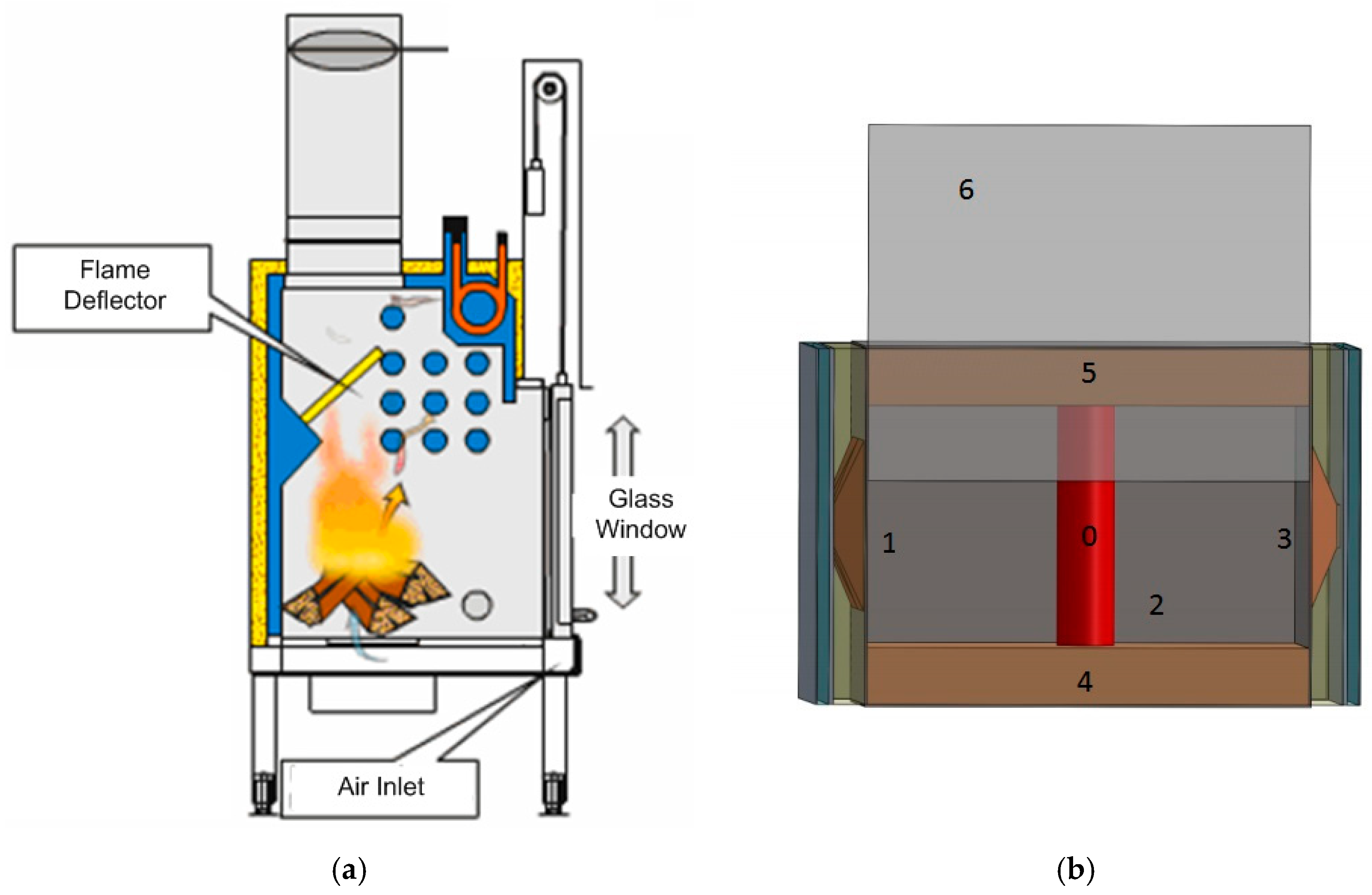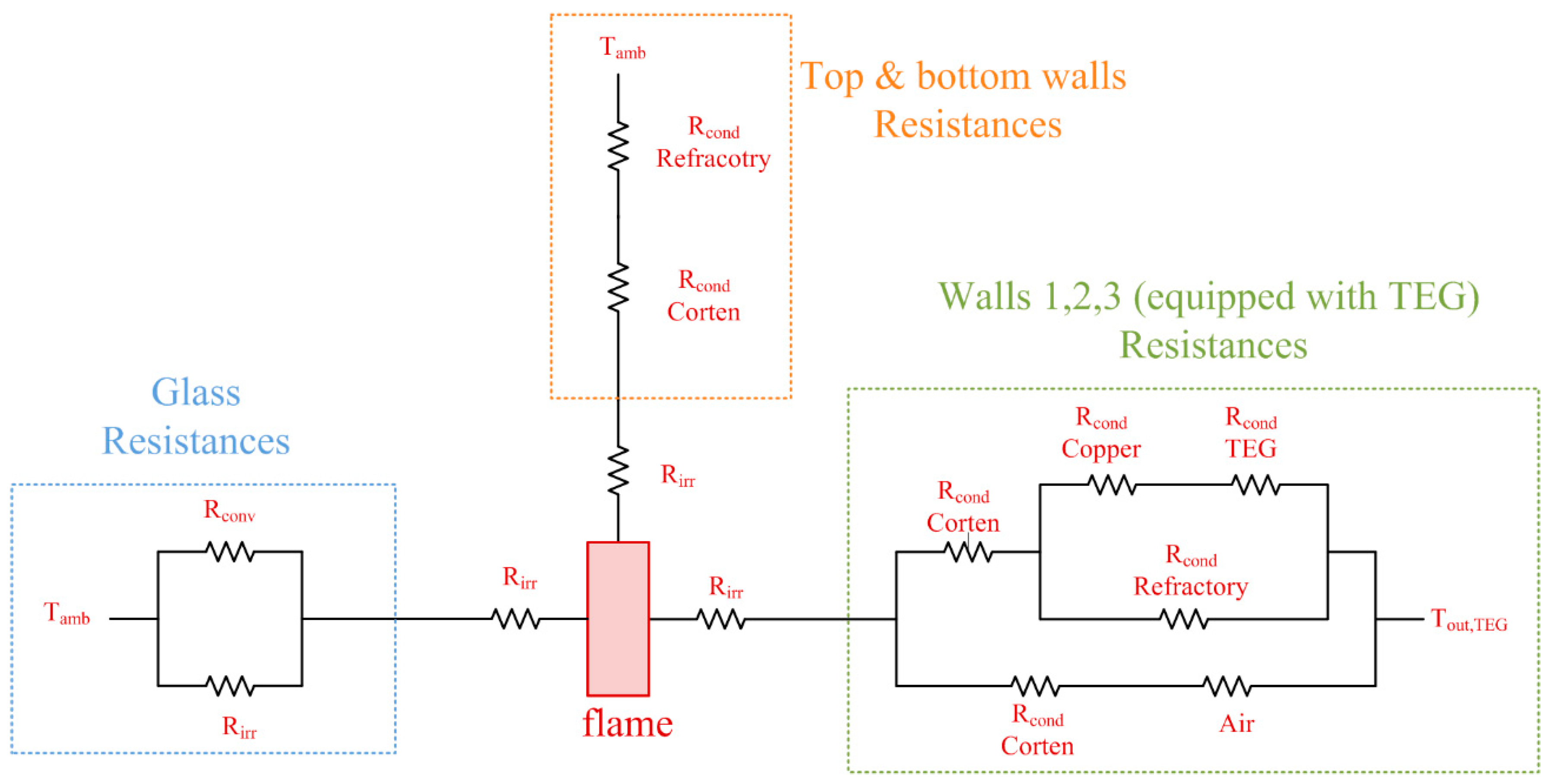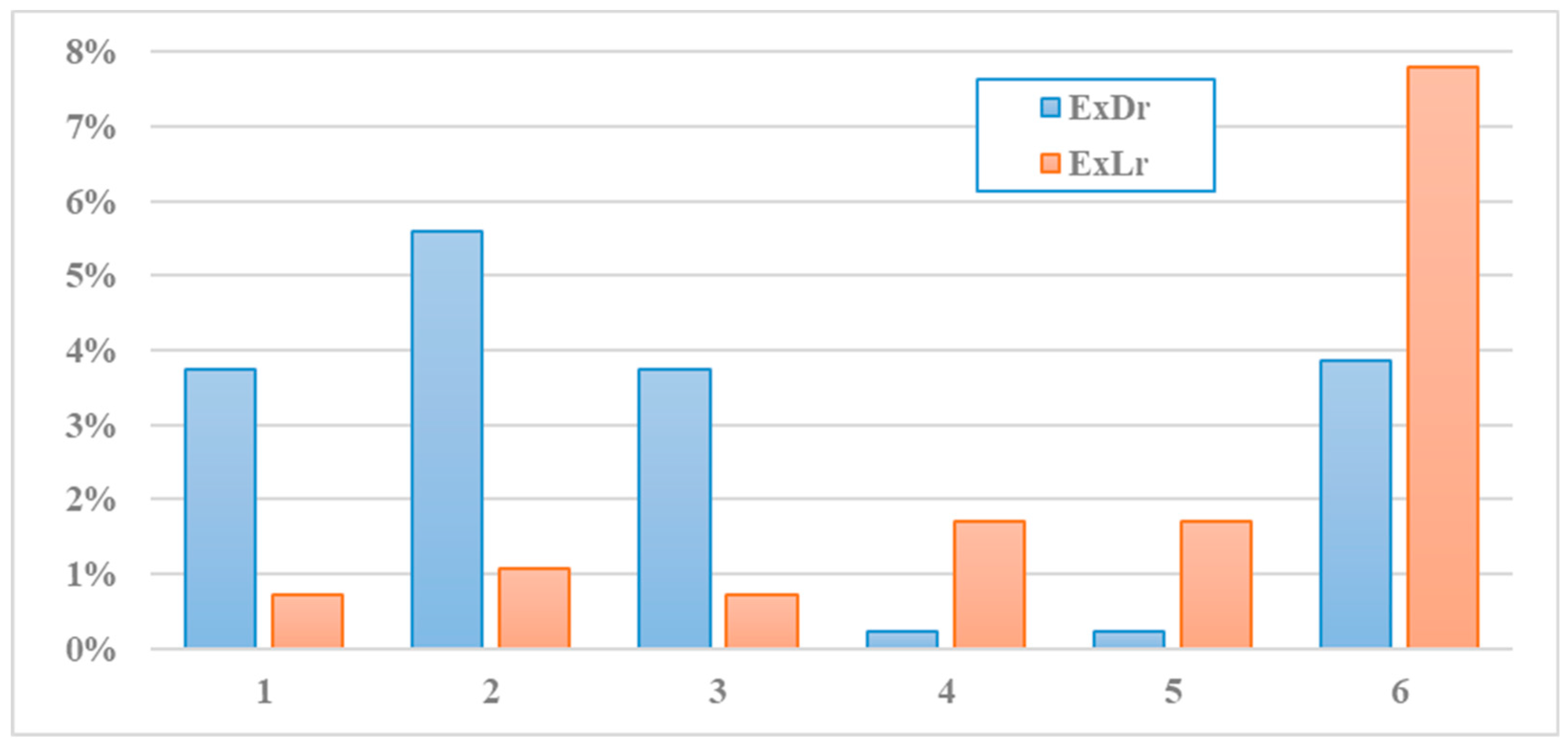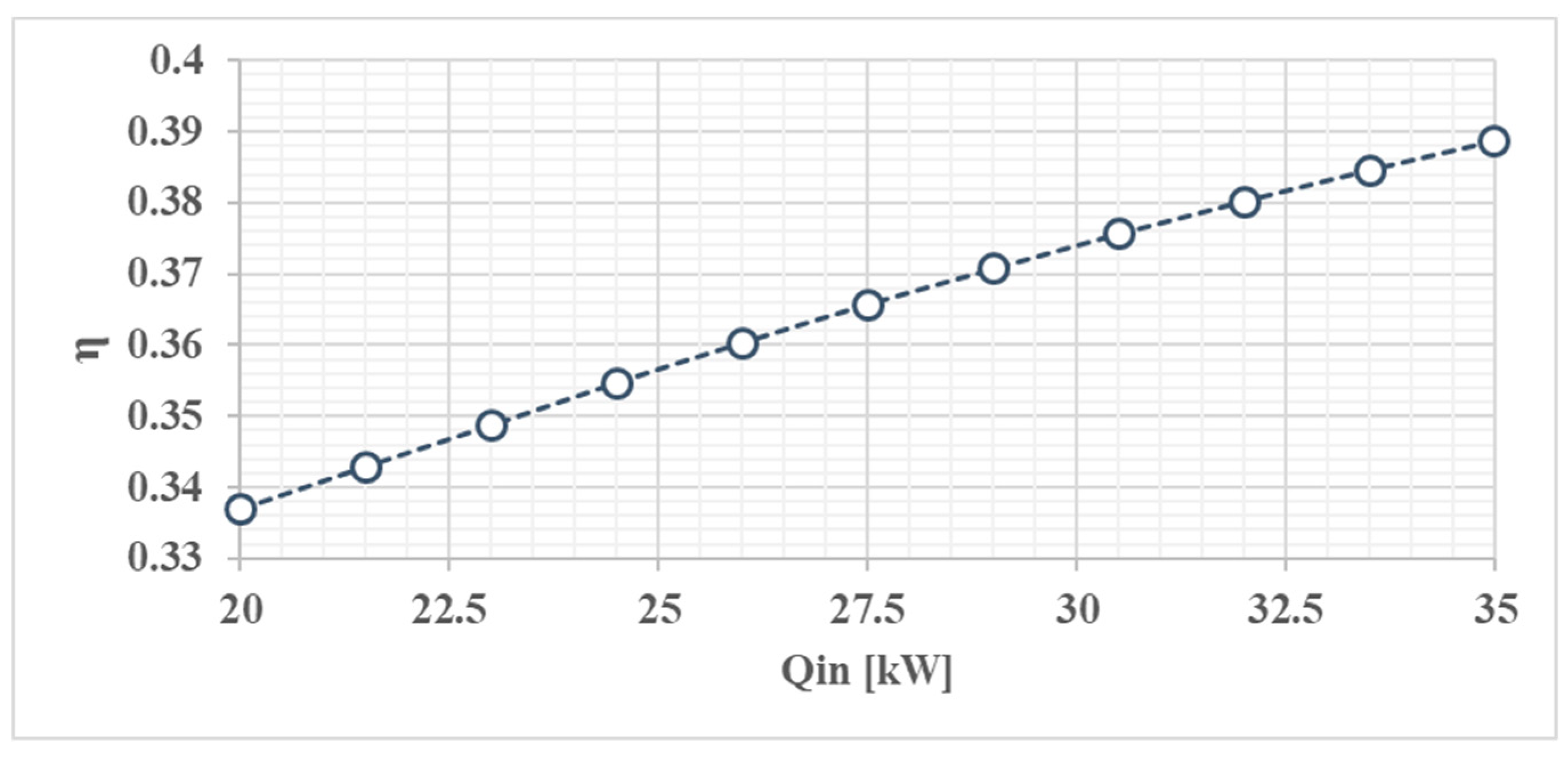Exergy Analysis of a Wood Fireplace Coupled with Thermo-Electric Modules †
Abstract
:1. Introduction
2. Materials and Methods
2.1. Layout of the Fireplace Unit
2.2. Thermodynamic and Exergy Model of the Thermo-Electric Fireplace
- Radiation model of the combustion chamber;
- Wavelength selectivity of the glass window;
- Heat transfer to thermo-electric modules (in/out);
- Heat flux concentrator.
3. Results
3.1. Exergy Destruction and Losses of Design Configuration
3.2. Sensitivity Analysis of the Main Parameters Affecting the Exergy Efficiency
4. Discussion and Conclusions
Author Contributions
Conflicts of Interest
Nomenclature
| A | Surface, m2 |
| HFC | Heat flux concentrator |
| TEG | Thermo electric generators |
| Ex | Exergy, kW |
| ExD | Exergy destruction, kW |
| ExL | Exergy loss, kW |
| h | Heat transfer coefficient, W/(m2 K) |
| H | Height of fireplace, m |
| Lpm | Liters per minute |
| PBP | Payback period |
| Q | Heat, kW |
| Mass flow rate, kg/s | |
| Temperature, K | |
| R | Conduction resistance |
| Greek symbols | |
| α | Absorption coefficient |
| ε | Emissivity |
| η | Exergy Efficiency |
| σ | Stefan–Boltzmann constant |
| Subscripts and superscripts | |
| Amb | Ambient |
| Cond | Conduction |
| Conv | Convection |
| Ext | External |
| f | Fuel |
| fg | Flue gases |
| In | Inlet |
| Int | Internal |
| Irr | Radiation |
| Out | Outlet |
| p | Product |
| r | Relative |
| 0…6 | Reference sections of fireplace |
Appendix A. Model of Combustion Chamber
Appendix B. Heat Transfer to Thermo-Electric Modules
References
- Lund, H.; Ostergaard, P.A.; Connolly, P.; Van Mathiesen, B. Smart Energy and Smart Energy Systems. Energy 2017, 137, 556–565. [Google Scholar] [CrossRef]
- Ackermann, T.; Andersson, G.; Soder, L. Distributed generation: A definition. Electric Power Syst. Res. 2001, 57, 195–204. [Google Scholar] [CrossRef]
- He, W.; Zhang, G.; Zhang, X.; Ji, J.; Li, G.; Zhao, X. Recent development and application of thermoelectric generator and cooler. Appl. Energy 2015, 143, 1–25. [Google Scholar] [CrossRef]
- Champier, D.; Bedecarrats, J.P.; Rivaletto, M.; Strub, F. Thermoelectric power generation from biomass cook stoves. Energy 2010, 35, 935–942. [Google Scholar] [CrossRef]
- Champier, D.; Bedecarrats, J.P.; Kousksou, T.; Rivaletto, M.; Strub, F.; Pignolet, F. Study of a TE (thermoelectric) generator incorporated in a multifunction wood stove. Energy 2011, 36, 1518–1526. [Google Scholar] [CrossRef]
- Zheng, X.F.; Yan, Y.Y.; Simpson, K. Potential candidate for the sustainable and reliable domestic energy generation—Thermoelectric cogeneration system. Appl. Thermal Eng. 2013, 53, 305–311. [Google Scholar] [CrossRef]
- Nuwayhid, R.Y.; Rowe, D.M.; Min, G. Low cost stove-top thermoelectric generator for regions with unreliable electricity supply. Renew. Energy 2003, 28, 205–222. [Google Scholar] [CrossRef]
- Nuwayhid, R.Y.; Shihadeh, A.; Ghaddar, N. Development and testing of a domestic woodstove thermoelectric generator with natural convection cooling. Energy Convers. Manag. 2005, 46, 1631–1643. [Google Scholar] [CrossRef]
- Lertsatitthanakorn, C. Electrical performance analysis and economic evaluation of combined biomass cook stove thermoelectric (BITE) generator. Bioresource Technol. 2007, 98, 1670–1674. [Google Scholar] [CrossRef] [PubMed]
- Ding, L.C.; Meyerheinrich, N.; Tan, L.; Rahaoui, K.; Jain, R.; Akbarzadeh, A. Thermoelectric power generation from waste heat of natural gas water heater. Energy Procedia 2017, 110, 32–37. [Google Scholar] [CrossRef]
- Sornek, K.; Filipowicz, M.; Rzepka, K. The development of a thermoelectric power generator dedicated to stove-fireplaces with heat accumulation systems. Energy Convers. Manag. 2016, 125, 185–193. [Google Scholar] [CrossRef]
- Sornek, K.; Filipowicz, M.; Zoladek, M.; Kot, R.; Mikrut, M. Comparative analysis of selected thermoelectric generators operating with wood-fired stove. Energy 2019, 166, 1303–1313. [Google Scholar] [CrossRef]
- Baldini, A.; Cerofolini, L.; Fiaschi, D.; Manfrida, G.; Talluri, L. Thermodynamic assessment on the integration of thermo-electric modules in a wood fireplace. Civ. Environ. Eng. Rep. 2019, 29, 218–235. [Google Scholar] [CrossRef]
- Szargut, J.; Morris, D.R.; Steward, F.R. Exergy Analysis of Thermal, Chemical, and Metallurgical Processes; Hemisphere Publishing Corporation: Washington, DC, USA, 1988. [Google Scholar]
- Kotas, T.J. The Exergy Method of Thermal Plant Analysis; Butterworths: London, UK, 1985. [Google Scholar]
- Bejan, A.; Tsatsaronis, G.; Moran, M. Thermal Design and Optimization; John Wiley & Sons, Inc.: New York, NY, USA, 1996. [Google Scholar]








| Dimensions | [m] |
|---|---|
| Overall Width | 1 |
| Overall Depth | 0.7 |
| Overall Height | 1.6 |
| Combustion Chamber Width | 0.78 |
| Combustion Chamber Depth | 0.5 |
| Combustion Chamber Height | 0.43 |
| # of TE modules | η [%] |
|---|---|
| 6 | 36.03 |
| 7 | 35.97 |
| 8 | 35.96 |
Publisher’s Note: MDPI stays neutral with regard to jurisdictional claims in published maps and institutional affiliations. |
© 2020 by the authors. Licensee MDPI, Basel, Switzerland. This article is an open access article distributed under the terms and conditions of the Creative Commons Attribution (CC BY) license (https://creativecommons.org/licenses/by/4.0/).
Share and Cite
Manfrida, G.; Talluri, L. Exergy Analysis of a Wood Fireplace Coupled with Thermo-Electric Modules. Proceedings 2020, 58, 10. https://doi.org/10.3390/WEF-06920
Manfrida G, Talluri L. Exergy Analysis of a Wood Fireplace Coupled with Thermo-Electric Modules. Proceedings. 2020; 58(1):10. https://doi.org/10.3390/WEF-06920
Chicago/Turabian StyleManfrida, Giampaolo, and Lorenzo Talluri. 2020. "Exergy Analysis of a Wood Fireplace Coupled with Thermo-Electric Modules" Proceedings 58, no. 1: 10. https://doi.org/10.3390/WEF-06920





